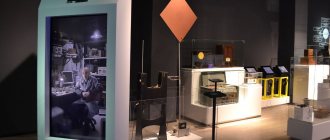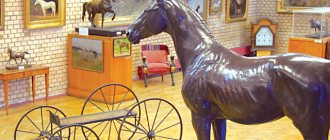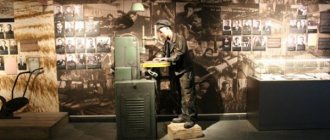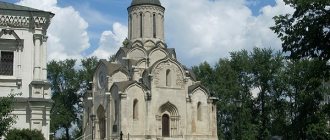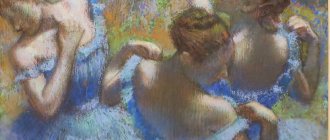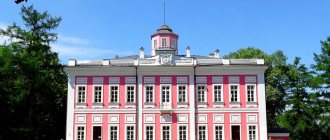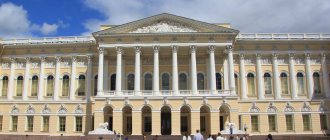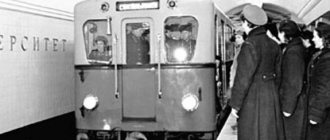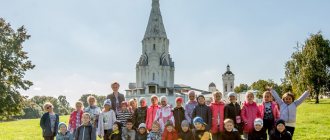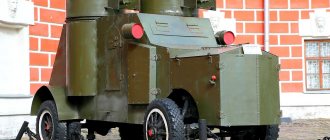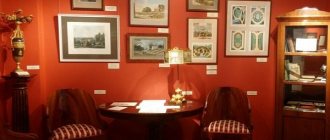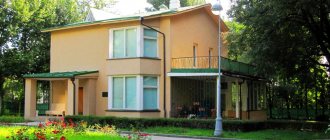: 22 Dec 2010, Study without destroying, volume 35, no. 5
The Moscow Polytechnic Museum is rightfully considered the main museum in Russia, representing the history of Russian science and technology. The rich museum collection, numbering more than 100 thousand exhibits, covers all fields of knowledge: physics, chemistry, biology, automation, metrology, computer technology, metallurgy, energy, transport, astronautics, mineral resources of the Earth, etc. Many collections are unique. For example, the collection of microscopes is one of the largest in the world, with about 1000 samples, from the first single-lens “fly” microscopes to electron microscopes of the 20th century. In addition, the Polytechnic has an extensive scientific and technical library, including a collection of rare publications, and the Central Lecture Hall, the famous Large Auditorium, which has more than once become a platform for the main characters of Russian history and culture
The Polytechnic Museum in Moscow is a national museum of the history of science and technology, one of the oldest scientific and technical museums in the world. Throughout its more than 137-year existence, it has repeatedly witnessed the most important historical and political events in Russian life, fundamental scientific discoveries, and meetings with remarkable people. The Polytechnic today is a large scientific complex, which, along with a rich museum collection numbering more than 100 thousand items, includes an extensive scientific and technical library and the Central Lecture Hall. In numerous halls of the museum there are exhibitions on automation, metrology, computer technology, physics, chemistry, mineral resources of the Earth, metallurgy, energy, transport, astronautics and other branches of knowledge.
The Polytechnic Museum is the first public institution in Russia, which was originally created to popularize scientific and technical knowledge among the general population. The idea of its occurrence was born in the 60s. XIX century, during the era of the reforms of Alexander II, when, as a result of the transformations carried out in the country, a certain liberalization of social life occurred, which allowed many scientific communities to develop their activities.
In 1863, the Imperial Society of Lovers of Natural History, Anthropology and Ethnography was established at Moscow University. The main goal of its founders was not only to promote science, but also to disseminate natural scientific knowledge among the population. They took the initiative to create an accessible educational museum in Moscow, designed to “serve for the people as a visual technical school in all branches of industry and the application of science to them”, “to promote the dissemination of information among insufficiently educated classes” (Soloviev, 1872, p. 134).
To begin with, it was decided to hold a Polytechnic Exhibition in Moscow, which would acquaint the Russian public with the most advanced scientific and technical ideas, while the most interesting exhibits would form the basis of future museum collections. This idea met with warm support from the authorities and business circles in Moscow. The exhibition was timed to coincide with the 200th anniversary of the birth of Peter the Great in order to ensure its patronage from the reigning house.
In the summer of 1872, in the very center of Moscow, as was written in the program, “in the Kremlin and around it, under the silent loopholes of the ancient defense, works of labor were exhibited.” The total area of the pavilions, which occupied the territory of the Manege, the Alexander Garden and the Moscow embankment (along the Kremlin wall to the Moskvoretsky Bridge), amounted to 20 hectares. About 10 thousand domestic and 2 thousand foreign exhibitors displayed their products there. 750 thousand people visited the exhibition, which exceeded the entire population of Moscow at that time.
The exhibition was a great success. It became a bright event not only in Russian, but also in international life. After its closure, the Committee selected the most interesting exhibits for the opening Museum of Applied Knowledge - the future Polytechnic Museum.
Camera Photographe Chevalier
The Photographe camera is one of the first acquisitions to the museum from the Moscow Polytechnic Exhibition of 1872. This is a box magazine daguerreotype camera with a combined P.V.C. photographic lens. (Photographe à Verres Combinés), in which cassettes inside a cassette magazine are moved manually. Both the camera and the photographic lens were designed by optician and physicist Charles Louis Chevalier in 1840.
In 1843, Sergei Levitsky, the first Russian photo artist and court photographer, traveled to the Caucasus and took photographs there. His camera was equipped with a PVC lens. Levitsky sent several of his best daguerreotypes to Charles Chevalier. In 1849, at the World Industrial Exhibition in Paris, Chevalier was awarded a gold medal for daguerreotypes with views of Pyatigorsk and its environs. This was the first highest award in the history of photography. So the P.V.S. lens became famous among his contemporaries - he was popular with photographers until the 1860s.
How the museum was created
In the second half of the 19th century, the idea was born to put on public display a collection of objects collected for the 200th anniversary of the Russian Tsar Peter I. In 1871, the city authorities allocated five hundred thousand rubles for the creation of a new museum.
A large construction site was laid out at 4 Lubyansky Proezd, near the building of the Committee of the Imperial Humane Society. The following year, a museum exhibition was opened in temporary halls on Prechistenka and a large-scale Polytechnic exhibition was presented to the public.
Construction of the main building lasted 30 years. Famous Russian architects took part in its design: Ippolit Antonovich Monighetti, Nikolai Aleksandrovich Shokhini, Georgy Ivanovich Makaev.
Telegraph apparatus of Pavel Schilling
The Schilling telegraph is the first electromagnetic telegraph in world history. Today, only two genuine Pavel Schilling devices exist. One of them is kept in the Central Museum of Communications in St. Petersburg, the other is on display at the Polytechnic Museum. Both devices were restored in 1886 - on the occasion of the centenary of the inventor's birth - by the chief mechanic of the St. Petersburg telegraph Ivan Derevyankin.
A member of the St. Petersburg Academy of Sciences, Schilling first demonstrated a “long-distance machine” in his apartment in October 1832. Two devices of the world's first electromagnetic telegraph line stood in different rooms. Using a special code, they transmitted numbers and letters at a speed of 10 characters per minute. “Contact” sessions were held regularly and could be attended before the Christmas holidays. Emperor Nicholas I was present at one of the demonstrations.
The invention of the electromagnetic device was an important scientific event: the telegraph code for the device laid the foundations for encoding information that are still used today.
History of the museum
At the very beginning, the museum had practical significance. Its exhibits comprised nine thematic sections, each of which was closely related to different areas of scientific knowledge.
In 1907, when the Great Auditorium was opened, eminent domestic and foreign scientists began to conduct experiments and give lectures in the building. Over the years, the museum audience listened to speeches by physicist Niels Bohr, biologist Ilya Ilyich Mechnikov and physiologist Kliment Arkadyevich Timiryazev. True, visitors came not only to scientific lectures. Alexander Blok, Vladimir Mayakovsky, and later Yevgeny Yevtushenko and Bulat Okudzhava performed their poems in front of crowded halls.
When the country participated in the First World War, the museum gave away many of its premises as infirmaries for those wounded at the fronts. In addition, there was an X-ray room here, which was actively used by all city hospitals. After the revolution, V.I. Lenin and Felix Dzerzhinsky gave speeches in the building.
In July 1919, by decision of the authorities, the museum became the Central Institute of Polytechnic Knowledge. Its employees began to conduct educational programs in various branches of science. They gave lectures to the general public and introduced them to achievements in the fields of physics, mathematics, natural science, economics and technology.
During the period of industrialization, the concept of the museum changed. It was used as a training center for workers. In the 1930s, the museum held a large-scale exhibition at which the results of the first Soviet five-year plan were presented to visitors. Museum guests were able to see achievements in the fields of energy, agriculture, metallurgy, fuel and chemical industries.
After the end of World War II, the museum became subordinate to the Knowledge Society. It became an educational center and was engaged in scientific training of the broad masses of the population.
Car "Russo-Balt K12/20"
The Polytechnic Museum houses a collection of unique cars manufactured before 1918. Among them there is a Russian car “Russo-Balt K12/20” from 1911. This is the only passenger car of this brand that has survived to this day.
In the Russian Empire, Russo-Balt cars were produced using advanced technologies. In particular, for the first time in our country, the K12/20 model was equipped with an engine with all cylinders cast in one block. The car reached speeds of up to 60 km/h. The famous poet, Grand Duke Konstantin Konstantinovich, retired Prime Minister Count Sergei Witte, Prince Boris Golitsyn, and industrialist Emmanuel Nobel rode the K12/20 with Landaulet bodies.
The exhibit, which is kept in the Polytechnic Museum, was discovered in 1963 in the city of Kimry, Kalinin region (today - Tver region). The car belonged to steam boiler mechanic Alexander Orlov. He bought the car in 1929 and drove it for almost 13 years until the car broke down: the owner forgot to drain the water from the engine cooling system for the winter. In 1966, Russo-Balt was acquired by the Gorky Film Studio, and in the same year it was bought from the studio by the Polytechnic Museum. For the 50th anniversary of the Great October Revolution, the car was restored at the Scientific Research Automobile and Motor Vehicle Institute, and soon it took its place in the exhibition.
We thank the Polytechnic Museum for their assistance in preparing the publication and for providing the illustrations.
News
News
Polytech is a partner of the Moscow Travel Hack 2021 hackathon
On March 27 and 28, the second hackathon in the field of digital travel solutions, Moscow Travel Hack 2021, will be held, organized by the Moscow Tourism Committee on
March 3Hackathon
- Museum and digital technologies
News
Polytechnic University begins digitizing the collection
There are plans to create an online collection of 2,500 items over the next five years.
First of all, it will include key items from the collection and thematic collections on March 1
- Museum and digital technologies
News
"Clouds of different sizes and colors"
The animation studio for migrant children is open again!
12th of February
- Special project
More
Notes
- ↑ 12
Ageeva, 2003. - Dolgov, 1993.
- ↑ 123
Kondratiev, 1996. - Moscow St. John the Theological Church near Elm (unspecified)
. Tree (May 14, 2013). Retrieved January 24, 2021. - ↑ 1234
Sytin, 1958. - ↑ 12345
Romanyuk, 2013. - ↑ 1234
Fedosyuk, 2009. - Gilyarovsky, 2005.
- Margarita Bulgakova.
The hall with mosaics in the house of Count Orlov-Davydov is recognized as an architectural monument
(unspecified)
. Evening Moscow (January 18, 2019). Retrieved January 24, 2019. - Parisian fashion (undefined)
. ArchNadzor (March 5, 2010). Retrieved January 24, 2021. - ↑ 12
Buseva, 1997. - Schoolboy, 2009.
- ↑ 12
Vostryshev, 2011, p. 510. - Dmitry Oparin.
Makaev's apartment building
(unspecified)
. Big City (April 18, 2011). Retrieved January 24, 2019. - Dmitry Anokhin.
Moscow specialists are systematizing the archives of the St. Panteleimon Monastery on Mount Athos
(unspecified)
. Journal of the Moscow Patriarchate and Church Bulletin (March 16, 2012). Retrieved January 24, 2021. - Schmidt, 1997.
- Morgan, 1935.
- Vostryshev, 2011, p. 576.
- The Church prevented the “second Manege” on New Square (unspecified)
. Komsomolskaya Pravda (December 20, 2010). Retrieved January 24, 2021. - ↑ 1 2
Hegumen Peter (Eremeev): Stop considering Muscovites as a powerless and dumb herd
(undefined)
. RIA "Federation News" (December 13, 2010). Retrieved January 24, 2021. - ↑ 1 2
Russian Geographical Society
(unspecified)
. RIA Novosti (October 19, 2015). Retrieved January 24, 2019. - Alexandra Borisova.
Girl with an atomic bomb
(undefined)
. Gazeta.ru (May 24, 2017). Retrieved January 24, 2021. - Tatiana Markina.
Top 10 “Moscow Restoration”: editor’s choice
(unspecified)
. The Art Newspaper Russia (December 4, 2017). Retrieved January 24, 2021. - Alexandra Artemenkova.
The best parks and courtyards of Moscow: new entertainment and colossal changes in the capital
(unspecified)
. Inforeactor (July 12, 2018). Retrieved January 24, 2021. - About the museum (undefined)
. Polytechnic Museum (2005). Retrieved January 24, 2019. - ↑ 123
Buseva, 1996.
What's on display today
The restoration is in full swing and will be completed in 2019-2020. But this does not mean that the museum is completely closed. So that visitors could see the unique collections, they were moved to other exhibition sites in the city.
Museum exhibits are presented in one of the pavilions on the territory of VDNKh, in the halls of Technopolis "Moscow" and in the premises of the Cultural. For several years now, a modern Museum and Educational Center has been built in the capital, in which the Polytechnic University and Moscow State University named after M.V. Lomonosov will take part.
"Open Collection"
In 2014, the museum opened its holdings to wide access. Visitors get acquainted with the exhibits and observe the work of the museum. You can visit such an exhibition only by appointment, as part of a group. Tours run from Tuesday to Thursday three times a day: at 10:00, 12:00 and 15:00.
A sightseeing tour for a group of 6-12 people costs 2,400 rubles, and an interactive program costs 3,000 rubles (2018). Once a week, museum staff conduct free excursions for children from low-income families, orphans and the disabled.
The collection is located in Technopolis, within walking distance from the Moscow metro station “Textilshchiki”. To better preserve the exhibits, the temperature in the halls is maintained at +18°C, so visitors are asked to come in warm clothes.
Polytech at VDNKh
Since the spring of 2014, while the main building is being renovated, the interactive exhibition complex “Russia Does Itself” has been opened at VDNKh. It introduces visitors to outstanding Russian scientists and modern Russian developments. In addition, those who visit here can take part in scientific experiments.
The exhibition is divided into seven thematic sections. Tourists are shown a model of the first Soviet atomic bomb, Chebyshev's unique plantigrade machine, Tsiolkovsky's rocket plane, an interactive model of the biosphere and beautiful patterns on ferromagnetic fluid. The guides talk about the operating principle of the holographic table and ionophone, the structure of the exoskeleton and artificial lightning.
Pavilion Transport of the USSR (Agriculture)
In the halls there are many monitors with headphones, wearing which anyone can listen to a lecture in Russian or English. At the exit there is a machine that sells space food.
The exhibition is open every day except Monday: on weekdays from 11:00 to 19:00, and on weekends from 11:00 to 21:00. Admission for adults costs 350 rubles on weekdays and 400 rubles on weekends. For discount tickets you need to pay 150-200 rubles (2018). Schoolchildren are admitted free of charge. Please note that the ticket office closes one hour before closing.
